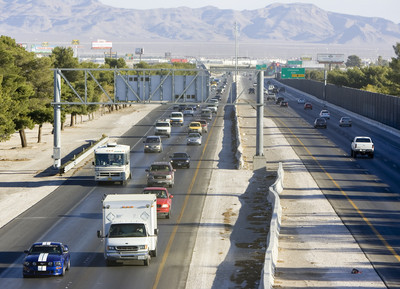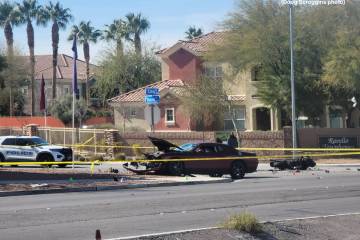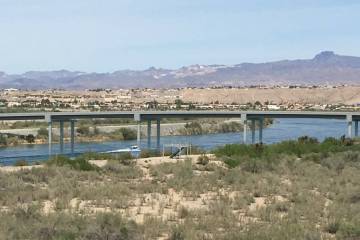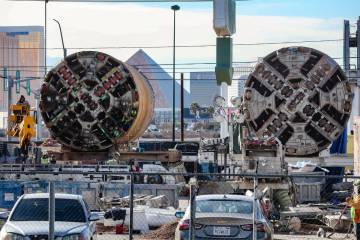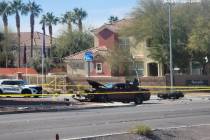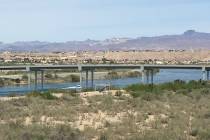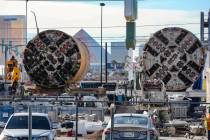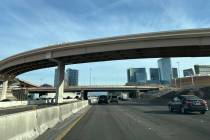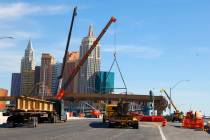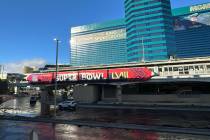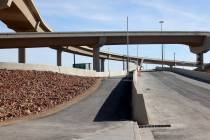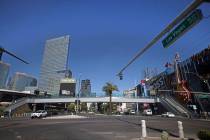I-15 widening job getting old, which is good
It's about time. Nevada Department of Transportation officials are no longer exclusively relying on their old (technically, more modern) ways of constructing roads and are turning to a methodology first seen in the Babylonian era.
The "design-build" scheme, which will be used to improve Interstate 15 from the Spaghetti Bowl to Craig Road, dates back to 1800 B.C. and is written in the Code of Hammurabi, recognized as the first formal legal code.
It's an old method that is being used to rebuild an old road; at least it's old by Las Vegas standards. That portion of I-15 was built in the 1960s, and little has been done to improve it since then, though traffic on it has grown to more than 170,000 vehicles a day.
What use of design-build will mean, according to state Transportation Director Susan Martinovich, is that one company will be able to more quickly design and construct the road improvements for the 5.5 miles of heavily congested Interstate. State officials hope the project, which has already begun in part, will be finished in three years.
At least 12 building methods are recognized by the U.S. Department of Commerce. Design-build and design-bid-build, the method more frequently used by the Transportation Department, are most common.
Design-build overlaps the designing and building phases of a construction project. On a design-bid-build project designing must be completely finished before a construction firm begins work, with time in between to put the contract out to bid.
If you hadn't figured it out already, U.S. Highway 95 was a design-bid-build project.
The idea of one construction company being in charge of an entire project has become fairly popular in recent years, but it has been around since ancient Mesopotamia, according to University of Colorado professors Anthony Songer and Keith Molenaar.
During the Renaissance, designers and builders split into two professions as the need for specialization grew with increasingly complex projects. They stayed separate until the 1970s and 1980s, when it became advantageous for companies to blend the two elements because of increases in inflation and lawsuits.
Nevada has now caught up to a number of public and private entities that have already embraced the method.
Arizona, California and Utah all have design-build constructed highways. The most recognizable was the multibillion-dollar reconstruction of I-15 in downtown Salt Lake City. That project was completed in little more than four years to meet the demand of the 2002 Winter Olympics.
Around the same time, Nevada was in the midst of reconstructing U.S. 95, which took 10 years to complete.
I'll let you do the math.
Kent Cooper, assistant director for planning at the Transportation Department, said design-build wouldn't have worked on U.S. 95 because there was too much right of way purchasing that needed to be done.
But even Cooper can't ignore the time difference between U.S. 95 and the I-15 project north of the Spaghetti Bowl.
"I-15 is simpler. There's far less right of way to be done. But three years to 10 years ... that's not much of a comparison," Cooper said.
The project will widen I-15 from six to 10 lanes from the Spaghetti Bowl to Lake Mead Boulevard and from four and five lanes to eight lanes from Lake Mead to Craig Road. The D Street, Lake Mead, Cheyenne Avenue and Craig interchanges will be reconstructed, and bridges at D Street, Bonanza Road and Washington Avenue will be rebuilt.
The project will be designed and constructed by North Corridor Constructors, a joint-venture between the Las Vegas Paving Corp. and engineering firm CH2M Hill, at a cost of about $250 million.
The design phase is already under way, and construction will start in the coming weeks.
There is already a lot of work that is under way, Cooper said. Staging areas for equipment and material pits are being readied, and the builders are ordering supplies they know they will need.
None of that would be going on yet if I-15 was a design-bid-build project.
Cooper said the project will cost less because the builders don't have to wait for the design to be finished before purchasing material, equipment and manpower, which are subject to rising inflation.
"The cost will be less by implementing things earlier," he said. "It's about saving time and in the process you save money."
If I-15 was a design-bid-build project, commuters would be waiting years for the design to be done before construction could start.
Who says several-millennium-old engineering ideas aren't better?
Those of us commuters who traverse I-15 north of the Spaghetti Bowl will have a good answer to that question in about three years.
If you have a question, tip or tirade, call the Road Warrior at 387-2904, or e-mail him at roadwarrior@reviewjournal.com or fmccabe@reviewjournal.com. Please include your phone number.
ROAD WARRIORMORE COLUMNSDiscuss this column in the eForums!
There will be extensive road closures throughout the valley today for the Las Vegas Marathon. The general area to avoid is from Las Vegas Boulevard to Torrey Pines Drive and from Carey Avenue/Smoke Ranch Road south to Twain Avenue. Road closures will start in the wee hours today, and the entire 26.2 mile course will be completely closed by 5 a.m. Roads will begin reopening as runners complete sections of the course. Motorists can expect delays on Twain Avenue and the surrounding areas in the coming weeks as the Clark County Water Reclamation District continues its sewer pipeline rehabilitation project. The following work can be expected: Drivers should expect one northbound lane, one southbound lane and the center turn lane of Twain Avenue, from Sandhill Road to Boulder Highway, to be closed through at least Dec. 18. Drivers should also expect one northbound lane, one southbound lane and the center turn lane of Viking Road, from Spencer Street to McLeod Drive, to be closed through at least Dec. 23. The two right traffic lanes of U.S. Highway 95 northbound at Jones Boulevard, the northbound Jones onramp and the U.S. 95 northbound Summerlin Parkway flyover will be closed from 11 p.m. Saturday to 5 a.m. next Sunday for graffiti removal and guard rail installation, according to the Nevada Department of Transportation.



